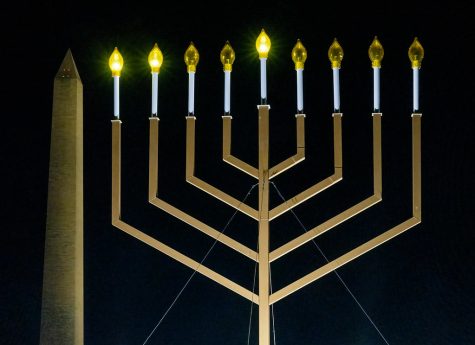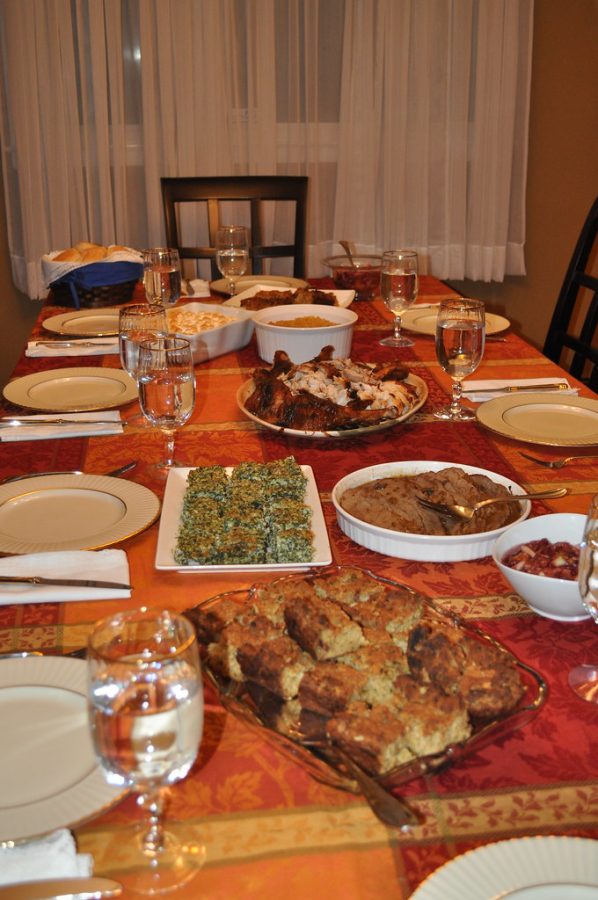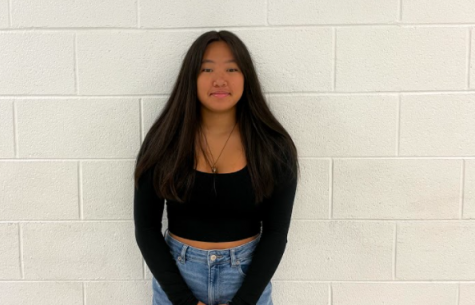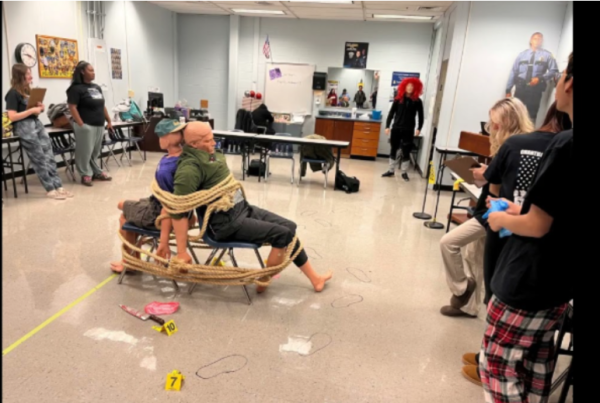WINTER HOLIDAY ORIGINS
Photo courtesy of Creative Commons
Thanksgiving feast.
Cinnamon, cloves, cardamom, snow, vanilla, ginger, honey, cold fresh air, chocolate, and firewood are the scents of the holidays. Reminisce and envision those smells while reading through the origins of favorite winter holidays and the festivities fellow bulldogs partake in.
During the holiday season people often get swept up in all the hectic festivities and forget the meaning behind it all. It is important to recognize the lives of others, whether they are loved ones or strangers. The holidays bring awareness to the ones less fortunate; in turn numerous opportunities arise for us to assist or give back to those in need. Reflect upon what one possesses and what they can do to provide comfort to one less fortunate. In light of the common saying; “The holidays are for giving”.
In these cold months we are not just given the celebration of one holiday but several. . First comes Thanksgiving, the day to show gratitude and sit down at a table with loved ones and share a heartfelt meal. Following Thanksgiving is the American tradition of Black Friday. Then comes Christmas, Hanukkah, and Kwanzaa.
Behind Thanksgiving, the holiday of blissful gluttony, is great historical value. In 1621, the Plymouth Colonists (pilgrims) and Wampanoag tribe shared an autumn harvest feast. Among the pilgrims, there were: 22 men, four women and over 25 children and teenagers.
This is currently considered one of the first Thanksgiving celebrations in the colonies. Over two centuries later, Thanksgiving was celebrated by individual colonies and states. In 1863, in the midst of the Civil War, President Abraham Lincoln proclaimed a national Thanksgiving every November.
Fun fact, the first Thanksgiving menu is believed to consist of: turkey, onions, beans, lettuce, spinach, cabbage, carrots and peas. The menu didn’t stop there though, it also included: corn, blueberries, plums, grapes, gooseberries, raspberries, cranberries, mussels, lobster, bass, clams, oysters, and potatoes. Modern day Thanksgiving still keeps the tradition of preparing and enjoying a plentiful variety of foods.
Brian Nolton, probability and statistics teacher, declared,“ There is nothing better than my mothers Thanksgiving rolls.”
The name “Black Friday” was first used 145 years ago in New York, and it has nothing to do with Christmas shopping. The Erie Railroad’s president and vice president, Jay Gould and Jim Fisk, had a reputation for being two of Wall Street’s most ruthless financial masterminds. A months-long scheme to rig the gold market came to a head on September 24, 1869.
For weeks, Gould and Fisk had been driving up the price of gold by buying up massive quantities of the precious metal. When President Ulysses Grant realized what they were up to, he flooded the market with gold, causing a massive stock market fall. Because of the e-commerce deals, this day became known as “Black Friday.”
The modern-day Black Friday, which occurs on the Friday following Thanksgiving, is considered to have begun in Philadelphia in the 1950s or 1960s. The term was invented by police officers after the Army-Navy football game, which was customarily held on the Saturday after Thanksgiving, flooded the city with shoppers and tourists. The police officers who had to work the day after Thanksgiving dreaded it because of the traffic congestion, overcrowding of sidewalks and retail outlets, and increased stealing. The term caught on nationally in reference to a post-Thanksgiving, pre-Christmas shopping frenzy in the 1980’s.
Dayanna Corado, 11, asserted, “Although Black Friday is a hectic frenzy, camping out the night before with my family is a tradition I cherish.”
Christmas, also known as Nativity or Noȅl, is a sacred religious holiday and a worldwide cultural and commercial phenomenon. Christmas Day, December 25, has been a federal holiday in the United States since 1870. One of the first forms of Christmas was celebrated by early Europeans who recognized light and birth on the darkest winter days. When the worst winter days were behind them, they were able to rejoice and look forward to longer days and longer hours of sunlight.
In the 19th century Americans re-invented Christmas and changed it from a raucous carnival holiday, into a family-centered day of peace and nostalgia.. This reinvented Christmas included: the gleeful colors of red and green, Christmas wish lists, decorating the tree, writing to carols, Santa, gift giving/receiving and countless other traditions.
Deniz Seyhan, 10, shared, “I enjoy gift giving more than receiving, seeing the reactions of my friends and family open my gifts is a great feeling”
Carols are a big contribution to the holiday spirit. Carols were first sung in Europe thousands of years ago, but they were not Christmas related. They were pagan songs, sung at the Winter Solstice celebrations as people danced around stone circles. Carols used to be written and sung during all four seasons, but only the tradition of singing them at Christmas has really survived.
Christmas would not be Christmas without the legend of Santa; a fat jolly man who brings joy in the form of gifts to all the kids, on the “nice list”, in a red suit with his nine reindeer. His story stretches all the way back to the third century when Saint Nicholas, a wealthy compassionate monk, walked the earth and became the patron saint of children.
St. Nicholas made his first inroads into American pop-culture towards the end of the 18th century. First in December 1773, and again in 1774, a New York newspaper reported that groups of Dutch families had gathered to honor the anniversary of his death. The name Santa Claus originated from Nick’s Dutch nickname, Sinter Klaas, a shortened form of Sint Nikolaas.
Kwanzaa is a holiday celebrated in African American culture. The holiday was created by Dr. Maulana Karenga, a professor at California State University, after the Watts Riots in Los Angeles in 1966. Kwanzaa was created as a way to bring African Americans together as a community.
Hanukkah, a holiday celebrated in Jewish culture, is an eight-day celebration that commemorates the rededication of the Second Temple in Jerusalem. According to legend, Jewish peoples had risen up against their Greek-Syrian oppressors in the Maccabean Revolt. Hanukkah, meaning “dedication” in Hebrew, commemorates the miracle of light that took place when Judah rededicated the Temple to the Hebrew god.
The Hanukkah celebration revolves around the kindling of a nine-branched menorah, known in Hebrew as the Hanukiah. On each of the holiday’s eight nights, another candle is added to the menorah after sundown. The ninth candle, called the Shamash (“helper”), is used to light the others. The Jewish population typically recite blessings during this ritual and display the menorah prominently in a window, as a reminder to others of the miracle that inspired the holiday.

“My favorite part about the holiday is singing the blessing while lighting the menorah with my family. Having the excitement of knowing I get to open gifts right after,” proclaimed Anna Kaplan, 11.
Traditional Hanukkah foods are fried in oil. Potato pancakes (Latkes) and jam-filled donuts (Sufganiyot) are particularly popular in many Jewish households. Other Hanukkah traditions include a game involving a four-sided spinning top called a Dreidel, cultural hymns, and exchanging gifts.
Holidays are about giving back and spreading love. Behind all of our favorite winter holidays is a much deeper meaning. While celebrating and enjoying all the holiday festivities this winter, give back by possibly sharing new found knowledge behind everybody’s favorite holidays while sitting around the table with loved ones.





